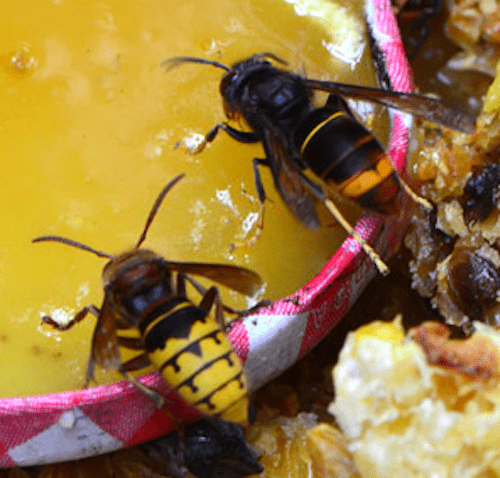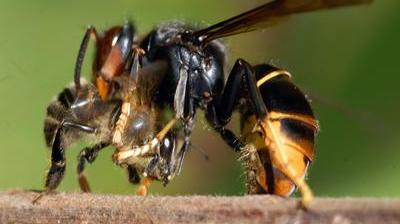A new stinging predatory insect pest is now reaching England. Unfortunately many people have been ill-informed about even what it looks like.
Although on average only about 30% of its prey are honeybees, it can wipe out a hive in just a few days.
It is a threat to all native insects – essential for pollination – including (but not only) honeybees. Pollinators are already under threat due to pesticides and habitat destruction. Adding a new and horribly efficient predator would have a very significant impact.
Humans are also threatened, particularly if they happen to disturb a nest, when they might get dozens of stings. It now kills a few people in France every year. According to those who have actually been stung, the sting is much more painful than a bee or wasp sting, and the pain can last for hours rather than minutes. In part this is because its longer stinger delivers the toxins deeper into the body, and there is a greater likelihood of many more stings.
In just 16 years, starting from a single Queen that stowed away amongst freight from China, it has spread across all of France, and into Spain, Portugal, Italy, Switzerland, Germany, Holland and Belgium. The rate of expansion has been about 50 miles per year, in all directions, which is spectacularly invasive.
It has been seen in the UK, but is not thought to have established reproducing colonies here.
Regarding Kent specifically, in 2019 it was found near Ashford, and the year before one was seen at Dungeness. It might be here now.
We are asking everyone to help to eradicate it,
whenever it appears in this country.
For that, you need to know exactly what to look for,
and what to do if you spot one.
Recognition
We call it “THE Asian Hornet”, as it is the only Asian Hornet species currently in Europe. But in Asia, there are many others. This one is called the “yellow-legged” hornet to distinguish it from those other hornets in Asia, but because we have lots of other, mostly harmless, yellow-legged insects in England, that name is rather unhelpful.
Its scientific name is Vespa Velutina nigrithorax, which does more helpfully indicate that this thing is largely black.

Importantly, the black Asian Hornet looks quite different to the (Asian) “Murder Hornet” that is appearing in the West of the USA, and which is therefore much reported (and illustrated) on the internet. Fortunately that one is in Asia and the USA, and is NOT over here!
That “Murder Hornet” is basically yellow (as is our own native hornet), whereas our invader is basically black. Unfortunately, many UK media reports have confused the invasive black Asian Hornet with both our native hornet and the internet’s Murder Hornet.
Our (rather rare) native hornet is a normal part of our ecosystem, not a disruptive threat and looks like a giant wasp (roughly an inch, 2.5cm, long), with the same yellow colouring.
The invader is about the same size and shape, but predominantly black. Blackness is its primary identification characteristic! If an insect is principally yellow, then it definitely isn’t our problem Asian Hornet.
The black Asian Hornet builds bigger colonies than our native hornet, and more of them, given the chance. As such it threatens large scale ecosystem disruption, as well as being an existential problem for beekeepers. It is also more “defensive” of its nest than the native hornet – it is quicker to attack intruders than our native one. And stirring up this “hornet’s nest” produces a much more violent response than from the yellow native hornet, with many more insects, each attacking more violently and persistently.
As a serious new pest, as long as the black Asian Hornet is not properly established, our (national) government authorities will respond to proven sightings, locate the nest and destroy it – at no charge.
However, the word “proven” is important. They need evidence before they will send anyone out, even to investigate. A clear photo is good evidence, and more safely obtained than a specimen insect! Unmolested, individual insects out looking for food, are not aggressive to people, and can be safely photographed.
Trapping or otherwise killing individual insects is not an effective control (because there are thousands more in the nest), so the public is advised not to try. To stop this thing, its nests must be found so that the entire colony can be destroyed. Nests however are highly dangerous, and 10 metres might be too close! This means that dealing with nests must be left to professionals with proper PPE (a beesuit is no protection). And they will respond (without charge) when alerted with compelling evidence.
Action
The UK government has sponsored the creation of a (free) App to help you identify the black Asian Hornet, and to distinguish it from some commonly-confused native insects (the App contains nearly 40 identification photos).
This same App is also the easiest way to submit your photo evidence of a sighting, direct to the right people – we beekeepers are not able to tackle this thing! The App is called Asian Hornet Watch and can be found in both Apple’s App Store and Google’s Play Store, as it works with Android, iPhoneOS and iPadOS.
If you have a smartphone or tablet, please download the App, and familiarise yourself (and your family) with what this pest looks like, (remember, it is mainly black!) and also what some of our large, but non-threat-posing, native insects look like.
Spot it – Snap it – Send it
The more eyes looking and able to correctly recognise the thing, the quicker an outbreak can be officially recorded and properly dealt with, minimising the chance of the pest becoming established here.
Speed matters because this pest multiplies very quickly indeed. Each nest could (in principle) produce hundreds of daughter nests for the following year. In France, its nest “R rate” seems in practice to be nearly 5, which is enough for very rapid expansion once a foothold is achieved.
Should you spot and photograph an Asian Hornet, the App only requires a couple of clicks to send in your sighting details.
But if you don’t have access to a smartphone or tablet, there are other identification resources available (see below) and sighting details with photos can be emailed to alertnonnative@ceh.ac.uk or else submitted via an online form at www.nonnativespecies.org/alerts/asianhornet
Feeding
Apart from hunting insects, they eat flower nectar, soft fruit and scavenge on dead animals and fish, as well as rotting fallen fruit.
Food source sites are the best place to get a clear photo.
Nests
In Spring, new Queens build a new nest in a sheltered spot – and French experience is that they frequently take advantage of man-made shelter. So take care to check sheds, porches, meter cabinets, garages, barns and the like for something that looks rather like a Wasps’ nest, but with big, black insects. It starts at egg-cup size and grows to a football.
At the start of Summer (around June), they move house and build a new much bigger nest – up to a metre across! They usually build this in a tall treetop. However about a third of the big Summer nests are actually lower – in hedges, bushes or even buildings, which of course is especially dangerous.
The Spring nest can be dealt with reasonably easily (by properly trained and equipped pest controllers). That prevents that colony developing into a massive, often hard-to-access, problem that would pump out new Queens for next year’s colonies unless promptly destroyed.
Because their nest-building involves pulping wood to something papery, they need access to lots of water. Hence nests are often found close to rivers, canals, ponds or other water sources.
Resources
Asian Hornet Watch – free App on Apple’s App Store and Google’s Play Store
UK Government Asian Hornet identification handout (PDF) here
Guernsey Identification Notes (with other ‘look-somewhat-alikes’) https://www.gov.gg/CHttpHandler.ashx?id=127811&p=0
Many internet resources are in French, as France has the most experience of the new pest. If you open the links using the Chrome web browser, you can get an English translation easily. YouTube auto-translated subtitles may be helpful, but struggle with slang and dialect!
Danger to humans, sting pain etc (do read the comments section!) http://anti-frelon-asiatique.com/dangers/agressivite-du-frelon-asiatique-et-danger-pour-lhomme/
Website of the “Manche” Département of France (#50) local government pest control federation, who have been good at putting their data online, and providing interesting links https://www.fdgdon50.com/Frelons-asiatiques/
The French Beekeepers “Union” is very concerned indeed https://www.unaf-apiculture.info/nos-actions/frelon-asiatique.html
YouTube channel of a French pest controller with a special interest and expertise in dealing with the “Frelon Asiatique” (his slang and accent isn’t easy, but the pictures speak clearly!)
Some French Identification leaflets http://frelonasiatique.mnhn.fr/wp-content/uploads/sites/10/2015/06/Fiches_Identification_Vespa_velutina_MNHN.pdf
http://roscoff.fr/IMG/pdf/identification-frelon-asiatique.pdf

